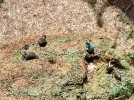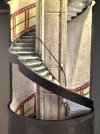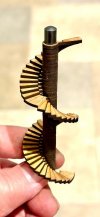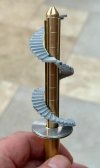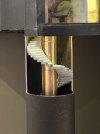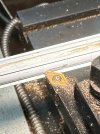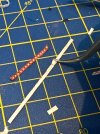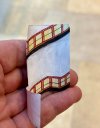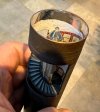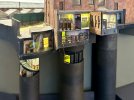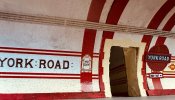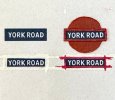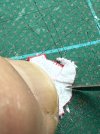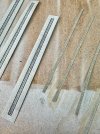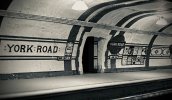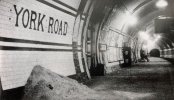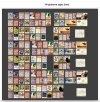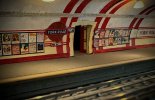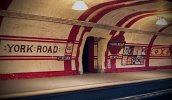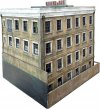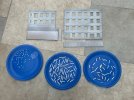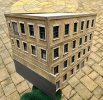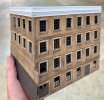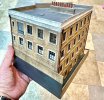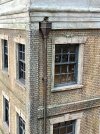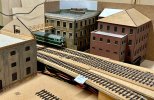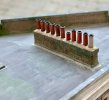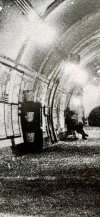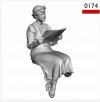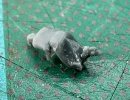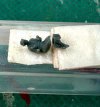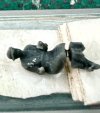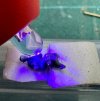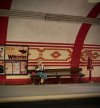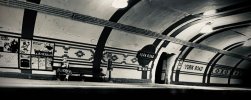In December, the MRC usually holds a pre-Christmas mini exhibition. The York Road tube diorama was having its first outing with a working train for the show. Whilst certain features such as the toilets and occupants are popular with all ages, I thought it was appropriate that the younger members of the audience get a preview of Santa Claus and his reindeer on a flight test. Having spent far too many hours making the underground tube station I wanted something nice and simple. Osborn Models came up trumps with a nice little 3DP of Santa in his sleigh with four reindeer out front.
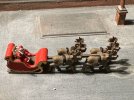
This had landed on the YR tube station roof and attracted many favourable comments from the audience, not least Phil Parker from BRM who was surprised to see such a model on CF. In discussion, I indicated that I thought it was capable of improvement, especially in the motive power department; CF is, after all, 2mm FS. Close examination reveals that the antlers and heads of the ‘reindeer’ pass a strong resemblance to a love child of a triceratops and a moose. There could be a case for an after-market bespoke antler etch if someone was very keen: I certainly didn’t fancy soldering up eight antlers from wire as an alternative. I then recollected that Preiser make some reindeer as a plastic moulding. Now these come as a very fine six pack in pairs, including four adorned with rather more plausible antlers. The challenge with these models was that they come in pairs and two of them would have looked as if Santa had done an emergency brake application with their heads down grazing. These therefore required plastic surgery with a triangular neck re-section.
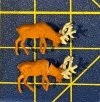
With the other pair I moved the head around on one of them to create a bit more variation. The Preiser reindeer are not too steady on their feet (maybe it’s not just carrots they have on Christmas Eve) and so some sort of location was required. A centre pole was made from metal strip and cross pieces of 0.4mm brass wire soldered in place. This replaced the chunky 3DP structure which was actually quite weak. At this stage the reindeer underwent key hole surgery with a 0.4mm tungsten carbide drill to locate the cross pieces just behind their withers. The antlers were also trimmed a bit.
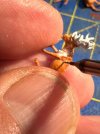
After a fair bit of thinning down of the sleigh edges with a scalpel and very sharp chisel the whole assembly was given a puff of grey primer, to show any major defects.
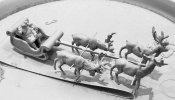
At this point I had a serious look at reindeer liveries on-line. They are very similar to dairy shorthorn cattle with a mixture of beige, yellow ochre, umber & white. The antlers would generally be darker shades. The noses are generally pink and of course one of them (Rudolph) has a red nose. Any bridles / tackle were painted on with a fine brush. The parcel load in the sleigh was augmented with extras and some are carrying the initials of the grandchildren. The gold lining on the sleigh was re-instated using a fine line gold marker pen.
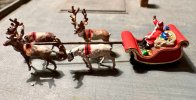
Finally, I thought that the sleigh ought to carry some aircraft recognition marks for Lapland. These are OH-JLP. Those of you that know about these things will recognise that OH is the symbol for Finland and JLP is a shortened form of Joulopukki, Finnish for Santa Claus, or literally ‘Christmas Goat’. So now you know.
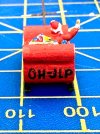
Of course you could save yourself a great deal of work by purchasing a Modelu Santa & sleigh 3DP, which came out just as I started this project, but where’s the fun in that?
I look forward to seeing the grandchildren’s faces when they see Santa Claus on CF.
Tim








